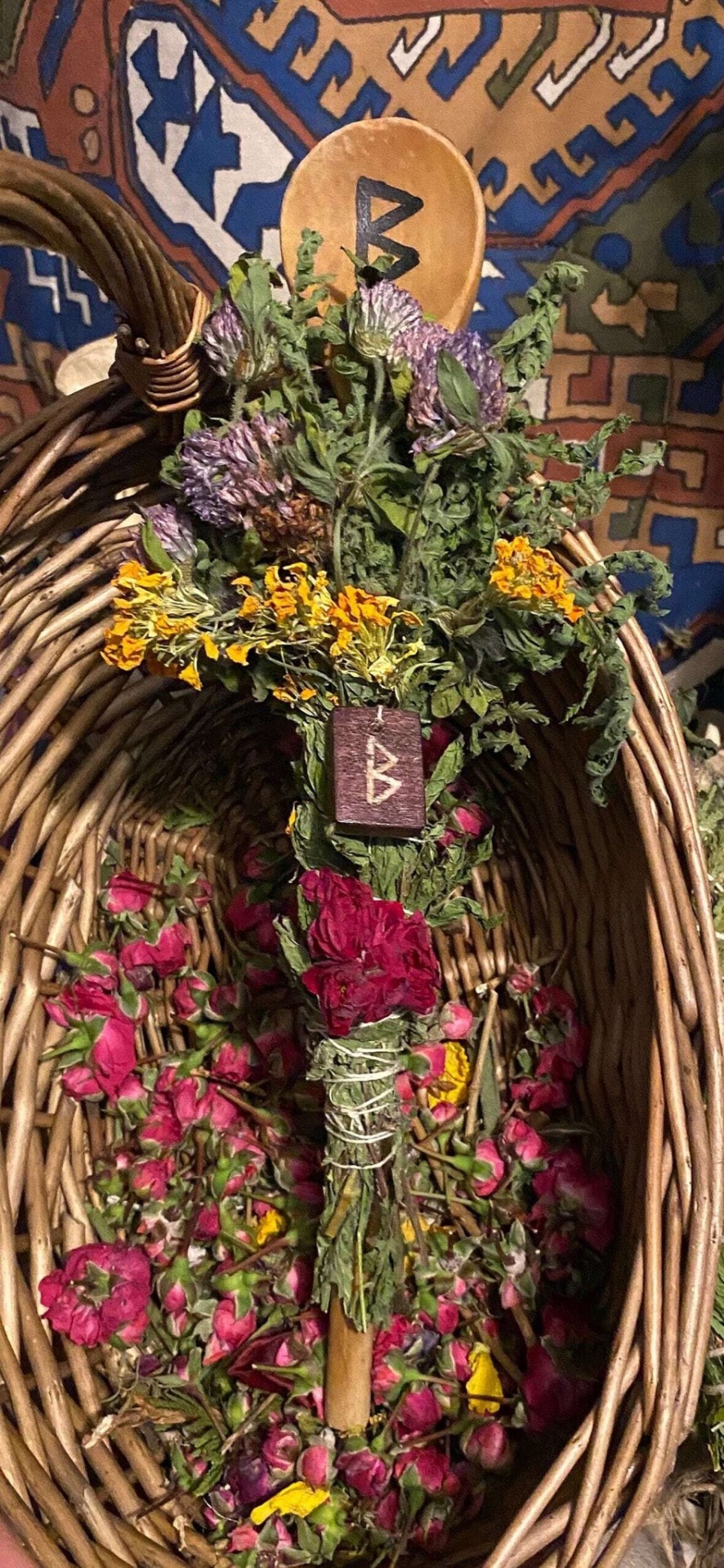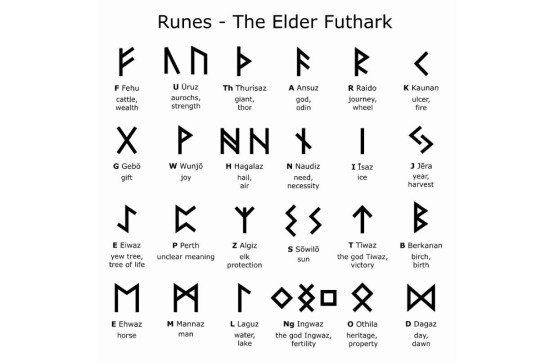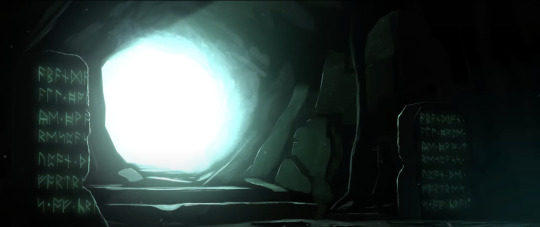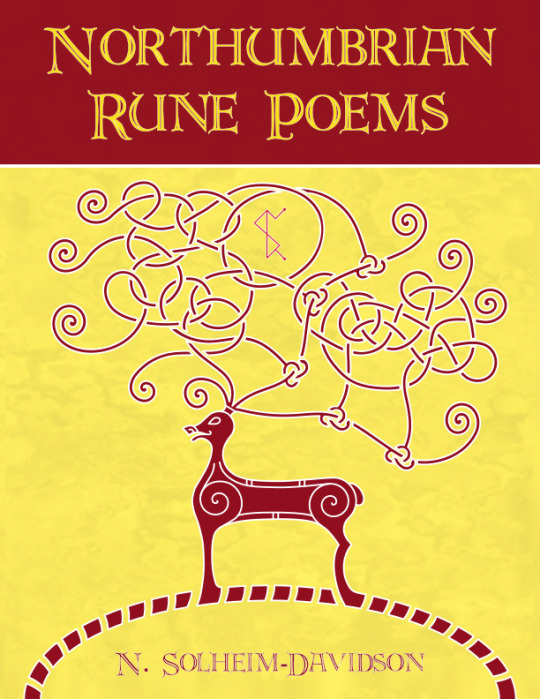#anglo saxon runes
Explore tagged Tumblr posts
Text

Posted by Freya Diana Wotan via Viking Mythology Group [Facebook]
#runes#Rune#elder futhark#futhark#futhark runes#elder futhark runes#rune#icelandic runes#long branch runes#short branch runes#anglo saxon runes#anglo saxon futhorc#norse runes
62 notes
·
View notes
Note
Okay I got another ship
Brahmi x Anglo-Saxon Runes
They already love eachother very much 😌😌😌
Absolute soulmates
Meant to be
Star crossed lovers
Lol... We should bring back those script fr tho.. it would be so fun
7 notes
·
View notes
Text
ᛣᚩᛚᛞ᛫ᚹᛁᚾᛏᚱ᛫ᚾᚪᛁᛏ
ᛣᚩᛚᛞ᛫ᚹᛁᚾᛏᚱ᛫ᚾᚪᛁᛏ. ᛋᚾᚩ᛫ᚠᚪᛚᛋ᛫ᛋᛚᚩᚢ. ᛗᚢᚾ᛫ᛋᚳᚱᚪᚢᛞᛖᛞ᛫ᛁᚾ᛫ᛣᛚᚪᚢᛞ. ᚪᛁᛋ᛫ᚪᛞᚩᚱᚾᛋ᛫ᚦᚪ᛫ᛏᚱᛇᛋ. ᚸᚪᚾ᛫ᛁᛋ᛫ᛏᚪ᛫ᛚᚪᛁᛏ ᚠᚱᛟᛗ᛫ᛗᛇ᛫ᛚᚪᛝ᛫ᚪᚸᚩ. ᛁᚾᚾᚱ᛫ᛞᚪᚱᛣ᛫ᛋᚩ᛫ᛚᚪᚢᛞ. ᚪᛁ᛫ᚠᛇᛚ᛫ᚩᚾᛚᛇ᛫ᚦᚪ᛫ᛣᚩᛚᛞ᛫ᛒᚱᛇᛋ.
2 notes
·
View notes
Text
Repurposed wooden spoons are wonderful for wall decor for the Heathen Home!

#heathenism#paganism#norse paganism#anglo saxon#medieval#pagan altar#witchcraft#runes#wiccecræft#norse deities#hearth#heathenhome
72 notes
·
View notes
Text
The Anglo-Saxon Rune poem.
Now this isn’t the only rune poem in existence there is Norwegian and Icelandic rune poems. Now I prefer Anglo-Saxon and believe it to be more accurate but there’s nothing wrong with reading the Norwegian or Icelandic and choosing it. But these said poems won’t have all the runes associated with the poems even some extra Runes or less than of the traditional Aetts. But right now I’m focusing on a the Elder Futhark which is all included in the Anglo-Saxon poem at times different names and translations.
This poem is also Galdr and speaking the poems you’re essentially invoking and evoking them. Runes are very powerful letters and magical symbols that must be treated with high respect. Some can be dangerous to use like ᚦ. It’s also used for anyone who wants to study and learn the runes in depth, reading the poems can gather your own interpretation of them. Also the Anglo -Saxon includes a few extra runes. I recommend if you were to use the actual Anglo Saxon Runes look and study the runes because yes it is describing the same rune some don’t look like the Elder Futhark, for instance Ansuz (Elder Futhark) and Aesc (Anglo Saxon) are the same rune but different name or meanings. Anglo Saxons did recreate the Ansuz rune but just putting it out there just because I'm putting the Elder Futhark runes doesn't equal to what that Anglo Saxons used.
ᚠ᛫ Feoh or Fehu - Cattle are compensation for everyone though each man shall greatly share his if he will be awarded honors from his Lord.
ᚢ ᛫ Ur or Uruz - Aurochs is brave and has horns above, this very firece animal fights with its horns, a great wanderer of the moors, it is a proud creature.
ᚦ ᛫ Thorn or Thuriaz - Thorn/Hawthorn is exceedingly sharp for every servant seizing it is evil, and it is extremely harsh to each man who rests among it.
ᚨ᛫ Os or Ansuz - The God is the creator of all language, wisdom's foundation and consolation of sages and everyman's joy and trust.
ᚱ ᛫ Rάd or Raidho - The Ride up to everyman's hall is comfortable and very fast for he who sits high on a mighty horse over the miles.
ᚲ ᛫ Cen or Kenaz - Torch/Pine is a tree known by all for its flame, shining and brilliant it often burns where people relax within.
ᚷ ᛫ Gyfu or Gebo - A Gift from other it is an honor and praise, a help and of worth and for sojourners everywhere a benefit and presence that is otherwise missing.
ᚹ ᛫ Wynn or Wunjo - A Joy possesses him who knows little want, illnesses, sorrows, and himself has prosperity and happiness and also a sufficient dwelling.
ᚺ ᛫ Hagal or Hagalaz - Hail is the whitest of seeds it's circling comes from the lofty sky, it tosses in the wind's shower, it then becomes water after words.
ᚾ ᛫ Nied or Nauthiz - Need is oppressive on the heart although it often befalls this affliction of men to help and to heal somewhat, if it is heard beforehand.
ᛁ ᛫ Is or Isa-Ice is extremely cold, very slippery, it glistens clear, like precious gems, a floor wrought by frost, fair thing seen.
ᛃ ᛫ Gear or Jera - Year is mankind's joy, when the God bequeaths, ruler of the sacred sky, the earth offers splendid crops for the wellborn and poor.
ᛇ ᛫ Éoh or Eihwaz - Yew is a rough tree on the outside, hard and secured in the earth, keeper of the fires, sustained by deep roots, it is a pleasure to have one one's land.
ᛈ ᛫ Peorth or Pertho - Gaming is always sport and laughter where boastful, they sit to make war in the banquet hall cheerfully together.
ᛉ ᛫ Eolk or Algiz - Elk-sledge is native to the marsh, it grows in the water, it can wound cruelly, the blood of any man burns who in anyway seizes it.
ᛋ ᛫ Sigel or Sowelio - The Sun for sailors is always hoped for when they depart over the fishes' bath, until their ship carries them to land.
ᛏ ᛫ Tir or Tiewaz - The North Star is one signal, it holds faith well with nobles, it is always on track, throughout night's darkness it never deceives.
ᛒ ᛫ Beroc or Berkana - Birch is without fruit it bears even so, it bears shoots instead of fruit, its branches are beautiful, high in the treetops decorated attractively, laden with foliage, lofty passage.
ᛖ ᛫ Eh or Ehwaz - Horse is for lords the joy of the aristocracy, horse hooves boastful, where around the hero, prosperous in respect to horses, it exchanges discourse, and its restlessness is ever to help.
ᛗ ᛫ Mann or Mannaz - Person with joy is beloved of his kin, even though each one depart away for moreover the lord wills his fate, the destitute flesh be delivered to the earth.
ᛚ ᛫ Lagu or Laguz - Water seems of endless length to people, if they must venture on unstable ships, and the sea waves terrify them exceedingly, and the ship does not heed its reins.
ᛜ ᛫ Ing or Ingwaz - Lord Ing was first seen among the east Danes it is said, until he later went back over the sea, his chariot following after, thus the brave men named that hero.
ᛞ ᛫ Daeg or Dagaz - Day is the god's ambassador beloved of men, the great god's light, Mirth and also hope, prosperous and poor, all enjoying it.
ᛟ ᛫ Ethel or Othila - Home is very dear to all people if there they have the opportunity to for justice and honesty while enjoying prosperity in the dwelling most often.
-------------------------------------------------
Additional runes to the Elder Futhark set
Ac - Oak is on Earth for the children of men, meat-animal's fodder it travels often over the gannet's bath, the sea tests whether the oak possesses noble truth. (The rune looks like F but the small arm on top is hooked like a check mark or small v and the bottom one is slanted like Ansuz.)
Aesc - Ash Tree, is lofty, glorified by men stiff in its trunk, it holds its position exactly, although it fights against many men. (I explained at top, this rune looks exactly like the Elder Futhark Ansuz - ᚨ)
Yr - Bow is for noble men and warriors everywhere joy and a more of distinction upon a fair horse, steadfast on its course , a part of the war gear. (This Rune is ᚢ but with a small line in between the legs)
Ior - Beaver is a river fish, and although he resides there, he forages there on land he had a fair dwelling, water surrounding that place he joy fully holds dear. (This rune is a straight line vertically with a X in the middle of the line)
Ear - The Ground is loathsome to all men, yet certainly the body will e set upon there, the corpse grows old, the soil accepts its pale bed-fellow, it leaves fall, pleasure depart, men cease to be. (This rune looks like ᛏ but the two small arms are hooked that look like small Vs or check marks)
And that’s it! I do recommend reading other translations and the other rune poem, at times different translations can be worded much better and help to understand a lot better. If you don’t really like the rune poem on this blog there’s nothing wrong either checking out Norwegian or Icelandic rune poems and to see if it will help you better!
#paganism#norse witch#norse paganism#norse pagan#norse runes#anglo saxon paganism#witchcraft#traditional witchcraft
23 notes
·
View notes
Text
The actual meaning of Runes

When dealing with runes, their name should be analyzed first. The alphabet is called “Futhark” based on the beginning letter of the first six runes’ names.
“Runes” aren’t a singularity. There’s the Elder Futhark and the Younger Futhark, also called Futhork. Than there’s also regional varieties such as the Nordic runes, Frisian runes, Anglo-Saxon runes and varieties due to changes through time. Something that looks like a rune but isn’t is called a “tectiform”.
Etymological there are plenty of Germanic varieties of the word. Rún is Old Norse/Nordic, Old Saxon rūna, Middle Dutch’s rune or ruin and rúna in Gothic. In Finnish runo means “poem”.
The word “rune” in essence means “secret” but is also a word used for “confidential conversation/writing”, “concealment” but also “counseling”.
The meaning of the word was held literally. It was not meant for basic administration, conversation or education. Few people actually knew how to read or write runes. It was reserved for a select but also elite part of society.
This brings us to Odin. The tales tell how he hung himself from the branches of Yggdrasil for nine days to gain the knowledge of runic wisdom. This makes him the god of the hanged (Hangagud), god of runes (Rúnatyr), father of magical songs (Fadir Galdrs) and wise one (Svidur). Knowing runes was viewed as knowing (some of) Odin’s magic and/or power.
Runes were used for “runic magic” a not very specified kind of magic in the Eddic texts. Individual runes were given names, such as the first rune, Fehu which means cattle or wealth. Naming individual characters is a common historic practice. These are not to be taken literally, but often are in modern esotericism and fantasy. Germanic Runic spells however are a weird thing. There are mystical inscriptions on the back of brooches, stones, wooden artifacts, etc. We know what they say, but not what they mean.
Mostly runes aren’t actually that far fetched. They are found on grave/memorial stones or a craftsman’s signature on an object. An example of this is the Nolby stone; “Bergsven and Sigfust and Fride raised this stone in memory of Bure, their father. Fartägn carved this stone”.
#frankish#merovingian#viking archaeology#archaeology#carolingian#charlemagne#field archaeology#viking mythology#merovingian archaeology#germanic mythology#norse runes#rune magic#norse mythology#anglo saxon#field archaeologist#frisian#odin#viking#vikings#germanic#germanic folklore#germanic archaeology#wodan#anglo saxon archaeology#history#jewelry#norse#poetic edda#proza Edda#rune stone
134 notes
·
View notes
Text

I figured out that these stones from Keeper of Celestial Flame say "abandon all hope ye hwo trespass upon the fortress of crail" because i couldn't find anyone else who translated it before me, but like, somebody else has gotta, this is not a new music video!
Yes, the typo was there
#the rune for ''y'' was mostly a guess based on context. and their ''o'' is a similar case#they dont have any parallels in the alphabets i looked up online-#waitasecond. false alarm.#i just dug up my ol' Dragonology book to look at its ''dragon script'' alphabet#and it's got the same runes that the music video used for ''y'' and ''o''#huh. i wonder why the sources i used online didn't show the same alphabet?#...OOOOH I JUST REALIZED IT'S BECAUSE THEY'RE ANGLO-SAXON RUNES AND MY DUMB ASS WAS LOOKING UP FUTHARK#THUS NEEDLESSLY COMPLICATING THE WORLDS SIMPLEST DECRYPTION#shitpost#gloryhammer#at least i got to see a typo. At least that's real. At least i have that.
15 notes
·
View notes
Text
just a girl with one (1) braincell



#academia#Yes This Is Technically Classwork#the manuscript at least#medieval studies#medievalcore#anachronism#Grendel's Mother kinnie#grendel's mother#mearcstapa#markwalking#Aggresive Liminality#if you think I mash up too many mythos you should see actual early-medieval sources bc good GODS#they would just throw anything and everything in there#manuscript#illuminated manuscript#illumination#pen work#wip#art wip#bookbinding#<kinda#multimedia#Long Ass Project#runes#norse mythology#anglo saxon#old english#greco roman#greco roman mythology
11 notes
·
View notes
Text

The Runes
by Ingrid Kincaid
Source
#Ingrid Kincaid#runes#rune#Rune#The Runes#anglo saxon futhorc#anglo saxon runes#anglo-saxon staves#futhorc#Futhorc Runes#northumbrian runes#norse pagan#rune magic#rune art
47 notes
·
View notes
Text

"Ôs is the well of all speech, wisdoms pillar and comfort of the wisemen, and each earls joy and confidence."
From the anglosaxon rune poem.
#dark photography#artists on tumblr#photo edit#art photography#original phography#germany#black and white photography#bnwphotography#black and white photo blog#black metal#norse paganism#pagan metal#paganism#anglo saxon#anglosaxon pagan#ansuz#ansuz rune#old english#woden#huginn and muninn
9 notes
·
View notes
Text

Northumbrian Rune Poems is now officially available for purchase. Digital and physical copies available here.
Inspired by the Old English Rune Poem, Northumbrian Rune Poems centres its focus on the Early Medieval English Futhorc runerows with additional attention paid to the four runes that were in use in Northumrbia. Mixing free verse poetry with kennings found within Old Norse and Old English poetry, Northumbrian Rune Poems is a magical read that breathes new life into an otherwise neglected runerow. Alongside each poem is an Old English adaptation written in a Northumbrian dialect using Old English alliterative style to capture the spirit of the poems in a new light.
#north sea poet#heathenry#poetry#my poetry#nico solheim-davidson#heathen#runes#futhorc#Northumbria#Heathen Poet#Heathen Poetry#north sea rune poems#northumbrian futhorc#anglo-saxon futhorc#anglo-frisian futhorc#rune poems#old english#anglo saxon
88 notes
·
View notes
Text
ᚻᛖᚱ ᛒᛁᚦ ᚠᛇᚻ ᛚᚫᚾᛖ ᚻᛖᚱ ᛒᛁᚦ ᚠᚱᛇᚾᛞ ᛚᚫᚾᛖ ᚻᛖᚱ ᛒᛁᚦ ᛗᚩᚾ ᛚᚫᚾᛖ ᚻᛖᚱ ᛒᛁᚦ ᛗᚫᚷ ᛚᚫᚾᛖ ᛠᛚ ᚦᛁᛋ ᛇᚱᚦᚪᚾ ᚷᛖᛋᛏᛠᛚ ᛁᛞᛖᛚ ᚹᛇᚱᚦᛖᚦ
Hér bið feoh lǽne, hér bið fréond lǽne, hér bið mon lǽne, hér bið mæġ lǽne, eal þis eorþan ġesteal ídel weorþeð!
Here money is fleeting, here friend is fleeting, here man is fleeting, here kinsman is fleeting, all the foundation of this world turns to waste!
(sang by Gealdýr) (full text of The Wanderer)
26 notes
·
View notes
Text
Hela bone offering with walnut stained bones. Available now!
#heathenism#paganism#anglo saxon#norse paganism#medieval#pagan altar#witchcraft#runes#norse deities#hela#hel#offerings#animal bones
11 notes
·
View notes
Photo

Meditation on the first Aett of the Anglo-Saxon Futhork
#pagan art#pagan#heathen#norse paganism#anglo saxon#runes#rune magic#sorceror#seidr#drawing#abstractart#experimentalart#experimentaldrawing#meditativeart#meditation#utiseta#witchcraft#chalk#charcoal#naturalpigments#nature#oldgods#spiritual#spiritualjourney#shamanism#shamanicart#visionaryart
133 notes
·
View notes
Text
Hello all and blessed be <3
I'm a closeted pagan, amateur herbalist and a novice folk/ hedge witch two years into my practice as I write this. I'm studying all Celtic, Anglo-Saxon, Appalachian and Norse witchcraft or folk practice. So I wanted to share my journey and knowledge somewhere, hence why I'm here.
I may not post consistently but I am going to post when I think of it. I'll be sharing anything from spirit, fair folk and deity work. Spells, folklore I've discovered or herbalism recipes. Just generally sharing my witchy and pagan journey somewhere.
#witch blog#witchy shit#hedge witch#pagan#witch stuff#grimoire#witchy vibes#witch aesthetic#celtic#ancient celts#anglo saxon#folklore#folk witchcraft#paganism#pagan witch#witchcraft#norse paganism#norse gods#norse mythology#norse runes#deity work#deity worship#herbalism#herbalist#foraging#faerie#cauldron#witches
16 notes
·
View notes
